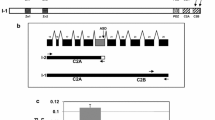Abstract
Several zebrafish P2X receptors (zP2X1, zP2X2, and zP2X5.1) have been reported to produce little or no current although their mammalian orthologs produce functional homomeric receptors. We isolated new cDNA clones for these P2X receptors that revealed sequence variations in each. The new variants of zP2X1 and zP2X5.1 produced substantial currents when expressed by Xenopus oocytes, however the new variant of zP2X2 was still nonfunctional. zP2X2 lacks two lysine residues essential for ATP responsiveness in other P2X receptors; however introduction of these two lysines was insufficient to allow this receptor to function as a homotrimer. We also tested whether P2X signaling is required for myogenesis or synaptic communication at the zebrafish neuromuscular junction. We found that embryonic skeletal muscle expressed only one P2X receptor, P2X5.1. Antisense knockdown of P2X5.1 eliminated skeletal muscle responsiveness to ATP but did not prevent myogenesis or behaviors that require functional transmission at the neuromuscular junction.






Similar content being viewed by others
References
Burnstock G (2007) Physiol Rev 87(2):659–797 doi:10.1152/physrev.00043.2006
Mulryan K, Gitterman DP, Lewis CJ, Vial C, Leckie BJ, Cobb AL et al (2000) Nature 403(6765):86–89 doi:10.1038/47495
Finger TE, Danilova V, Barrows J, Bartel DL, Vigers AJ, Stone L et al (2005) Science 310(5753):1495–1499
Sim JA, Chaumont S, Jo J, Ulmann L, Young MT, Cho K et al (2006) J Neurosci 26(35):9006–9009 doi:10.1523/JNEUROSCI.2370-06.2006
Kucenas S, Li Z, Cox JA, Egan TM, Voigt MM (2003) Neuroscience 121(4):935–945 doi:10.1016/S0306-4522(03)00566-9
Diaz-Hernandez M, Cox JA, Migita K, Haines W, Egan TM, Voigt MM (2002) Biochem Biophys Res Commun 295(4):849–853 doi:10.1016/S0006-291X(02)00760-X
Kimmel CB, Ballard WW, Kimmel SR, Ullmann B, Schilling TF (1995) Dev Dyn 203(3):253–310
Li H, Coghlan A, Ruan J, Coin LJ, Heriche JK, Osmotherly L et al (2006) Nucleic Acids Res 34(Database issue):D572–D580 doi:10.1093/nar/gkj118
Ruan J, Li H, Chen Z, Coghlan A, Coin LJ, Guo Y et al (2007) Nucleic Acids Res 36(Database issue):D735–D740 doi:10.1093/nar/gkm1005
Buss RR, Drapeau P (2000) J Neurophysiol 84(3):1545–1557
Westerfield M (2000) The zebrafish book. A guide for the laboratory use of zebrafish (Danio rerio), 4th ed. University of Oregon Press, Eugene
Boue-Grabot E, Akimenko MA, Seguela P (2000) J Neurochem 75(4):1600–1607 doi:10.1046/j.1471-4159.2000.0751600.x
Egan TM, Cox JA, Voigt MM (2000) FEBS Lett 475(3):287–290 doi:10.1016/S0014-5793(00)01685-9
Norton WH, Rohr KB, Burnstock G (2000) Mech Dev 99(1–2):149–152 doi:10.1016/S0925-4773(00)00472-X
Appelbaum L, Skariah G, Mourrain P, Mignot E (2007) Brain Res 1174:66–75 doi:10.1016/j.brainres.2007.06.103
Rettinger J, Schmalzing G (2004) J Biol Chem 279(8):6426–6433 doi:10.1074/jbc.M306987200
North RA (2002) Physiol Rev 82(4):1013–1067
Clyne JD, Wang LF, Hume RI (2002) J Neurosci 22(10):3873–3880
Ennion SJ, Evans RJ (2002) Mol Pharmacol 61(2):303–311 doi:10.1124/mol.61.2.303
Wilkinson WJ, Jiang LH, Surprenant A, North RA (2006) Mol Pharmacol 70(4):1159–1163 doi:10.1124/mol.106.026658
Marquez-Klaka B, Rettinger J, Bhargava Y, Eisele T, Nicke A (2007) J Neurosci 27(6):1456–1466 doi:10.1523/JNEUROSCI.3105-06.2007
Roberts JA, Digby HR, Kara M, El Ajouz S, Sutcliffe MJ, Evans RJ (2008) J Biol Chem 283:20126–20136
Surprenant A, Rassendren F, Kawashima E, North RA, Buell G (1996) Science 272(5262):735–738
Kolb HA, Wakelam MJ (1983) Nature 303(5918):621–623 doi:10.1038/303621a0
Hume RI, Honig MG (1986) J Neurosci 6(3):681–690
Thomas SA, Hume RI (1990) J Gen Physiol 95(4):569–590 doi:10.1085/jgp.95.4.569
Meyer MP, Groschel-Stewart U, Robson T, Burnstock G (1999) Dev Dyn 216(4/5):442–449
Ryten M, Hoebertz A, Burnstock G (2001) Dev Dyn 221(3):331–341 doi:10.1002/dvdy.1147
Soto F, Krause U, Borchardt K, Ruppelt A (2003) FEBS Lett 533(1–3):54–58 doi:10.1016/S0014-5793(02)03751-1
Ruppelt A, Ma W, Borchardt K, Silberberg SD, Soto F (2001) J Neurochem 77(5):1256–1265 doi:10.1046/j.1471-4159.2001.00348.x
Ryten M, Dunn PM, Neary JT, Burnstock G (2002) J Cell Biol 158(2):345–355 doi:10.1083/jcb.200202025
Ryten M, Yang SY, Dunn PM, Goldspink G, Burnstock G (2004) FASEB J 18(12):1404–1406
Sandona D, Danieli-Betto D, Germinario E, Biral D, Martinello T, Lioy A et al (2005) FASEB J 19(9):1184–1186
Ryten M, Koshi R, Knight GE, Turmaine M, Dunn P, Cockayne DA et al (2007) Neuroscience 148(3):700–711 doi:10.1016/j.neuroscience.2007.06.050
Araya R, Riquelme MA, Brandan E, Saez JC (2004) Brain Res Brain Res Rev 47(1–3):174–188 doi:10.1016/j.brainresrev.2004.06.003
Saint-Amant L, Drapeau P (1998) J Neurobiol 37(4):622–632
Ennion S, Hagan S, Evans RJ (2000) J Biol Chem 275(38):29361–29367 doi:10.1074/jbc.M003637200
Jiang LH, Rassendren F, Surprenant A, North RA (2000) J Biol Chem 275(44):34190–34196 doi:10.1074/jbc.M005481200
Buchthal F, Folkow B (1944) Acta Physiol Scand 8:312–316
Hume RI, Thomas SA (1988) J Physiol 406:503–524
Bo X, Schoepfer R, Burnstock G (2000) J Biol Chem 275(19):14401–14407 doi:10.1074/jbc.275.19.14401
Jiang T, Yeung D, Lien CF, Gorecki DC (2005) Neuromuscul Disord 15(3):225–236 doi:10.1016/j.nmd.2004.11.008
Banachewicz W, Suplat D, Krzeminski P, Pomorski P, Baranska J (2005) Purinergic Signal 1(3):249–257 doi:10.1007/s11302-005-6311-0
Acknowledgements
We thank the members of the Kuwada and Hume labs, as well as Shawn Xu, Haoxing Xu, Geoffrey Murphy and Michael Uhler for helpful comments on the manuscript. SEL was supported in part by PHS training grant MH014279 (Huda Akil, PI). This work was supported by NSF grant IOS-0725976 and PHS grant NS036587 to JYK and NSF grant IBN-0077634 and PHS grant NS051001 to RIH.
Author information
Authors and Affiliations
Corresponding author
Rights and permissions
About this article
Cite this article
Low, S.E., Kuwada, J.Y. & Hume, R.I. Amino acid variations resulting in functional and nonfunctional zebrafish P2X1 and P2X5.1 receptors. Purinergic Signalling 4, 383–392 (2008). https://doi.org/10.1007/s11302-008-9124-0
Received:
Accepted:
Published:
Issue Date:
DOI: https://doi.org/10.1007/s11302-008-9124-0




